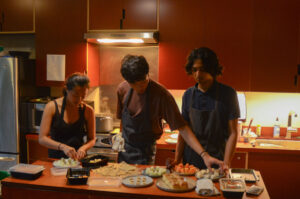| I recently had the chance to sit down with Aly Ogasian, an interdisciplinary artist and Assistant Professor of Art at Scripps College. Aly is constantly dreaming up and carrying out innovative courses and workshops here at The Claremont Colleges and has received multiple Course Activity Grants from the Hive. The Hive’s Course Activity Grants have supported Aly in bringing science and technology-based skills into her art courses, often by bringing other artists and makers into her classes as collaborators and teachers.
In this interview, Aly took me on a journey through her creative practice, from the power of curiosity and crazy questions, to her experience living on an artificial island in Kennedy Space Center, to how art acts as a cultural sponge.

Photos courtesy of alysonogasian.com
Read the interview with Aly here!
Surf’s up!
Ryan Lillestrand chose to attend Pitzer College partly because he had heard of professors Tim Berg and Adrian Pantoja’s course, where they explored surf culture and built surfboards from scratch. When Ryan arrived on campus, the course was no longer being offered. In his senior year, the course was still on his mind, so he decided to recreate the experience on his own – guided by the knowledge of the original professors.
In collaboration with the Hive and professors Berg and Pantoja, Ryan embarked on an academic and experiential “exploration of the deeply complex relationship between surfing and environmentalism.” He was particularly interested in how culture and history have shaped the materials used to craft boards. He researched “surfing’s roots, exploring the ways surfboards were crafted before polystyrene foam, fiberglass, and epoxy resin came into the picture.” His learning and building happened in parallel, informing each other as he went. Ryan just finished his first prototype, a paipo board, which he built in his garage over the summer based on his research and learnings thus far. He’s excited to test it on the waves soon!

Creativity Grants and You
If reading these stories sparked your imagination about what you might do with a creativity grant, you’re in the right place. We’re always looking for new projects and people to support through our creativity grants. A brief menu of options:
Student Creativity Grants: This grant program supports students who need access to creative resources such as funding, materials, space, or mentoring for their important creative endeavors.
Course Activity Grants: This grant program supports faculty (ideally interdisciplinary and intercollegiate teams of two or more) who want to infuse creative collaboration and feature experiential components of creating and making into their classrooms.
This can also be a mix-and-match, faculty-and-student collaborative situation. You could bring your Course Activity Grant class to the Hive to work on their projects alongside similar Student Creativity Grant projects. Another thing to consider is that you’re always welcome to use Hive spaces – maybe you want to host your class at the Hive or use one of our making spaces to bring more making into your class.
Are you ready to take the next step? Contact Linda Shimoda at linda.shimoda@hive.claremont.edu. We’re excited to hear more about your next big idea! |









